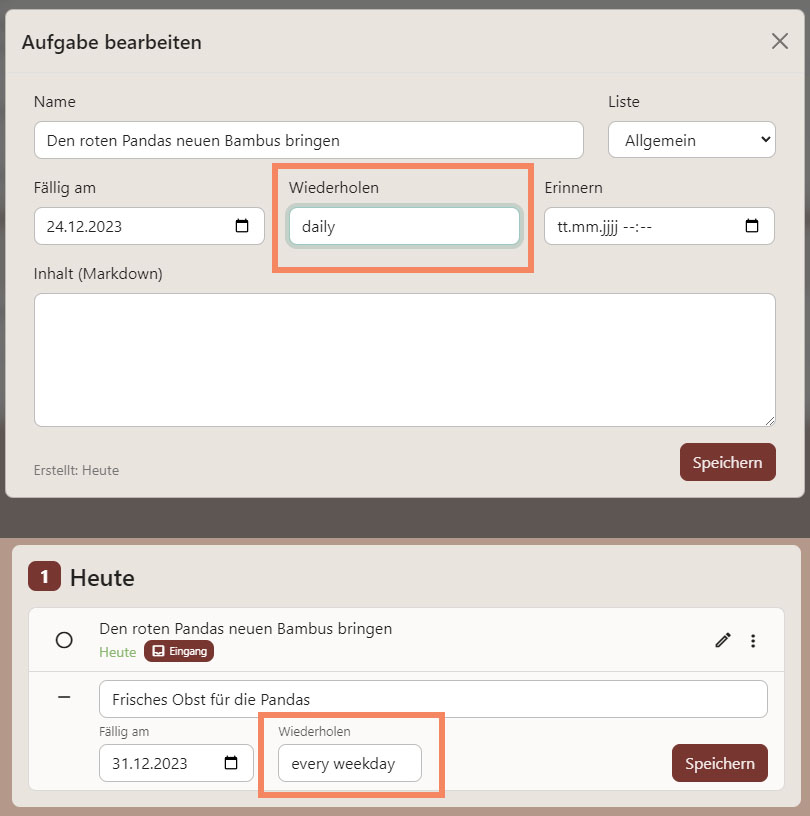Recurring Tasks for Busy Pandas
Red Pandas' Knowledge Base: Tasks
In our app, you can set up tasks and have them repeat themselves. Picture it like having your very own tiny red panda sitting in an office reminding you of your tasks. You can input these repetitions either as text or with a Cron expression. And hold onto your bamboo—our pandas are tirelessly working on more options coming soon!
Input
You can input your desired interval in the "Repeat" field when creating and editing a task:

Text-based Repetitions
To repeat your tasks, you can use these texts:
| Text | Meaning |
|---|---|
every mon |
Your panda will remind you of your task every Monday. |
every tue / wed / thu / fri / sat / sun |
This, of course, also applies to all the other days of the week. |
daily |
Your panda will remind you of this task every day. |
monthly / every month |
On the first day of every month, your panda will give you a nudge. |
quarterly / every quarter |
Every first day of the quarter, your panda is on it. |
every weekday |
Your panda is all over it from Monday to Friday. |
every weekend |
Your panda will remind you of this task on the weekends. |
And if you want your panda to only remember every 2, 3, 4, or 6 months, you can do that with every 2 months,
every 3 months, every 4 months or every 6 months.
If you specifically want to be reminded on the 24th of a month, simply add at 24, like every 3 months at 24.
Of course, you can take any other day of the month this way.
Cron Expressions
Alright, let's strap in and dive deep into the world of Cron expressions.
A clever red panda once devised a nifty system for quickly and succinctly expressing recurring tasks. These are called Cron expressions.
A Cron expression consists of 5 values, separated by spaces. They look like this: 0 0 * * *. Since our tasks
are always due daily and there is no specific time (only reminders have those), the first two values are
always "0". Let's take a closer look at the remaining three values:
- The third value represents the day of the month. You can put a number from 1 to 31 here.
- The fourth value is for the month. Here you can put a number from 1 (for January) to 12 (for December).
- The fifth value is the day of the week. Here you can put a number from 0 (for Sunday) to 6 (for Saturday).
Here are some examples of Cron expressions:
| Cron Expression | Meaning |
|---|---|
0 0 * * * |
This means that the task is due every day, so it's the same as daily. |
0 0 * * 2 |
This means that the task is due every Tuesday (2 stands for Tuesday). |
0 0 5 * * |
This means that the task is due every fifth day of the month. |
0 0 */3 * * |
This means that the task is due every three days. |
0 0 12 */2 * |
This means that the task is due every 2 months on the 12th day of the month. |
Asterisks (*) mean "every". So * in the third field means "every day", * in the fourth field
means "every month" and * in the fifth field means "every day of the week".
You can also use the slash (/) to indicate intervals. For example, */3 in the third field means "every 3 days".
You can also indicate time ranges with a hyphen (-). For example, 1-7 in the third field
means "from the first to the seventh day of the month".
If you're not working with intervals/ranges but have specific times, you can also list them.
For example, 0 0 10,15,20 * * would remind you of the task on the 10th, 15th, and 20th day of each month.
We hope this helps you plan your tasks better! Remember, no matter how complicated your schedule may be, there's a little red panda somewhere ready to tackle it with you.
If you have any further questions, don't hesitate to contact us. Our red pandas don't bite — unless it's bamboo!